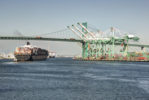
Visit Our Sponsors |
|
|
|
|
|
|
|
|
|
|
|
|
|
|
|
|
|
|
|
|
|
|
|
|
|
|
|
|
|
|
|
|
|
|
|
|
|
|
Visibility is top of mind for supply chain executives today, but they still need to sell the organization on the value of investing in that capability, says Jeffrey Luft, portfolio development executive with Siemens Digital Logistics.
Visibility in the supply chain is essential, “because if you can’t measure what you’re doing, you can’t improve it,” Luft says. Customers want to know the status of their orders, and manufacturers need to confirm that inbound goods for production are due to arrival on schedule.
In the past, customers had to be content with getting the goods when they showed up. Now, they’re demanding rapid service and complete visibility of product in transit throughout the supply chain.
To have visibility, of course, you need data. Companies need to take basic information derived from everyday operations and elevate it to the “sandbox level,” where they can experiment with ways to improve the flow of goods. And the way to do that today is through the use of a digital twin, a virtual representation of the supply chain that allows users to play out various “what-if” scenarios before implementing the optimal one in the real world.
Company finance officers must be convinced that the acquisition of such a system is worth the cost. Luft says the digital twin can make a compelling case for its value. But the speed of return on investment depends on the amount of resources that they’re willing to put into the effort.
In addition, Luft says, it’s important to involve experts from multiple disciplines within the company, to create the most effective supply chain. That includes individuals from sales and product design, the latter of whom have traditional preferred to work in a vacuum. But the involvement of everyone is needed “to mitigate possible risks down the road.”
RELATED CONTENT
RELATED VIDEOS
Timely, incisive articles delivered directly to your inbox.






